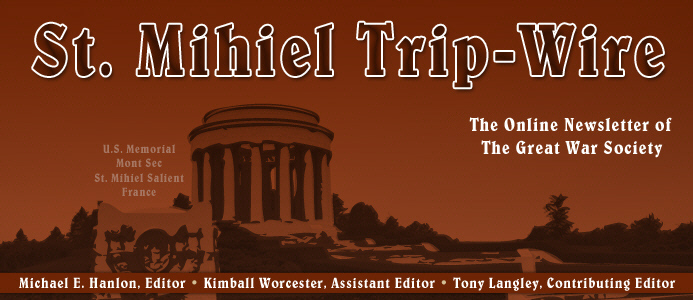

TRENCH REPORT: February marks the 95th anniversary of the longest battle of World War I. On 19 February 1916 German artillery opened up and with their opening salvo scored a hit on the grounds of the Cathedral Notre-Dame de Verdun. This marked the opening the 300-day struggle. In this issue, regular contributor Christina Holstein tells the story of the road the was the lifeline for French forces. 1916 was the year of the big signature battles -- Verdun, the Somme, Jutland, and the Brusilov Offensive. We will have features on each of these throughout the year. MH
This Month's Internet Feature
WWI Musical Videos
We had such an excellent response to our poetry videos that we thought you might enjoy some of the WWI songs that can be enjoyed online, some through movie dramatizations.
I Didn't Raise My Boy to Be a Soldier
Tipperary
Cagney/Cohan Writes Over There
Roses of Picardy
Smile, Smile (Pack Up Your Troubles)
Harry Lauder Sings The End of the Road
Three From Oh, What a Lovely War:
When This Lousy War Is Over
. . .Only Playing Leapfrog ??
There's a Long, Long Trail
New at Our Own & Our Friends' Great War Websites
Click on Title or Icon to Access
|
From the Smithsonian Air & Space Museum:
At Great War Society Sites
Major Articles at The Near East and the First World War
At WFA-USA Sites
|
It Had to Happen!: A World War I situation comedy is in the works in the UK Chickens will feature three individuals on the home front, who for various reasons aren't serving with the Army. (link)
The International Society for First World War Studies has inaugurated a new journal,
First World War Studies (ISSN 1947-5020), whose first issue appeared in March 2010. The Society was founded in 2001 by Jenny Mcleod and Pierre Perseigle. For details on the Society go to (their homepage).
Call for Papers: The Great War from Memory to History, an interdisciplinary conference will be held at the University of Western Ontario, London, Ontario, 10-11 November 2011. Email greatwar@uwo.ca for information.

Question: What is the proper pronunciation of "Ypres"
Answer Found at: http://www.howjsay.com/index.php?
word=ypres
|
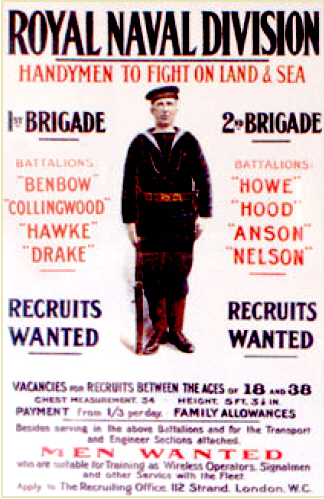
The 63rd, Royal Naval, Division saw extensive and wide service in the Great War including: the defense of Antwerp, Gallipoli, the Somme, Passchendaele, Cambrai, and the 1918 victory offensive.
|
GREAT WAR 2011 EVENT CALENDAR
|
A World War I Event Calendar
We will continue to maintain our WWI Calendar. There is simply more information than we can display here on the Trip-Wire. We count on all of you who schedule WWI events to contact us with new and updated information. Next month we will publish the 2011 calendar available to all.
(send an email with schedule information)
|
National World War I Seminar,
9-10 September, 2011
Citi-Garden Hotel
South San Francisco, CA
(Near S.F. International Airport)
(Check Back for Details)
|
WFA-Pacific Coast Branch Annual Seminar
March 4-6, 2011
Bay Street Armory,
Victoria BC
(flyer and registration form)
|
Western Front Association
U.S. Branch Chapter Meetings
Check for Your Region
Regularly Updated (details)
|
Great War Society Monthly Chapter Meetings
Berkeley, San Francisco, and
Palo Alto, CA
Regularly Updated (details)
|
Upcoming Events at the National World War I Museum
Kansas City, MO
New Exhibits and Lectures Scheduled
Regularly Updated (details)
|
Send additions/corrections for our master schedule:
Email Response
|
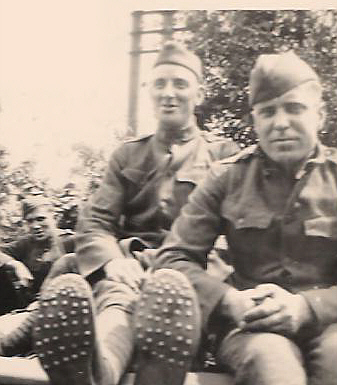
Hobnail Boots
See article on "Pershing Boots" (link)

I have never really been wounded. At the critical moment I have probably bent my head or pulled in my chest. Often I haven surprised that someone did not hit me. Once a bullet went through both my fur-lined boots. Another time a bullet went through my muffler. Another time one went along my arm through the fur and the leather jacket, but I have never been touched.
The Red Air Fighter (memoir),
Manfred von Richthofen, (KIA 21 April 1918)
|
|
|
|
Page Two
|
|
|
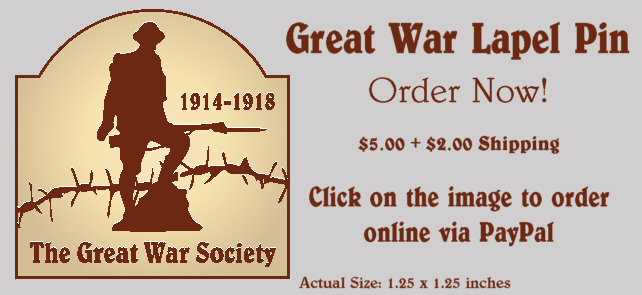 |
Someday Visit the Menin Gate at Ypres
If I should die, think only this of me:
That there's some corner of a foreign field
That is forever England.Rupert Brooke, Royal Naval Division, The Soldier, 1914 |
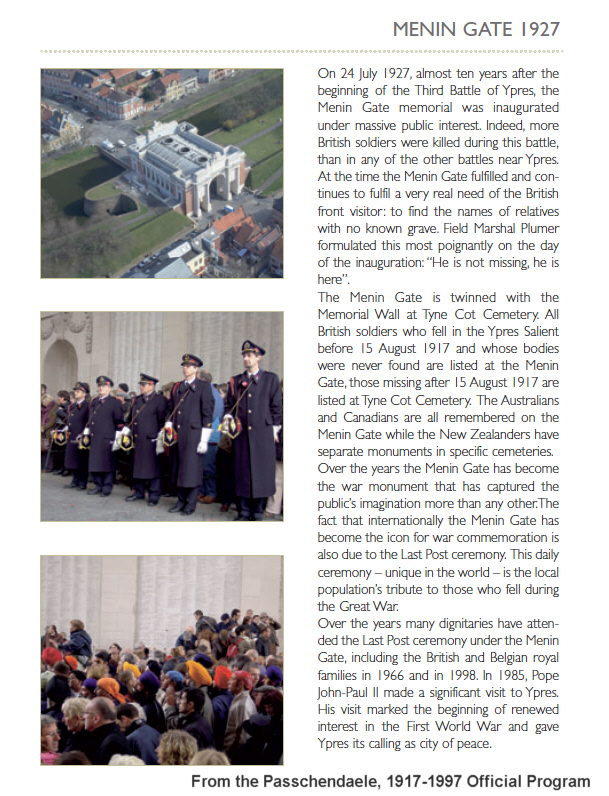
|
|
World War I Headlines
in the
21st Century
|
|
Christina Holstein's Sleeping Beauties
The Voie Sacrée Memorial
|
If you ever visit Verdun and wonder how a battle of such magnitude was supplied, visit the memorial to the troops who maintained the main French supply road during 1916. Today that route is known as the Voie Sacrée, or Sacred Way, but before the Battle of Verdun it was merely the winding and poorly surfaced road from Verdun to Bar-le-Duc, a city some 75 kilometres to the south. Who had ever heard of it then?
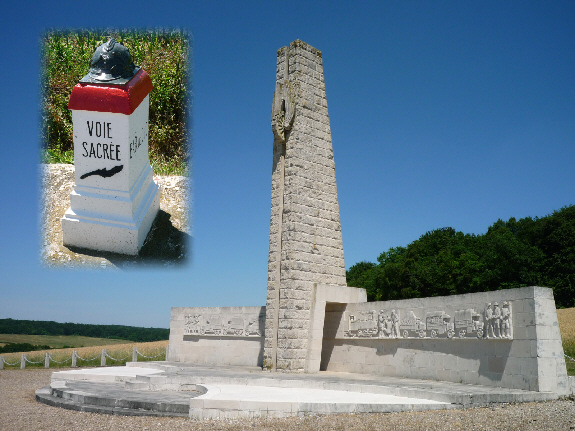
The Voie Sacrée Memorial, Roadway Marker (insert)
This unknown road was thrown into prominence in 1914 when the Germans attempted to pinch out Verdun rather than face it head on. Although the attempt was unsuccessful, it damaged or destroyed the main rail supply lines into Verdun and left the strongest fortified city in France dependent on one narrow gauge railway and this road. Over the next few months the road was widened, but as long as the Verdun sector remained quiet, further measures to develop it were deemed unnecessary and the later shortage of labour made major work impossible. That meant that when the battle of Verdun began, the road had to be used as it was. With military needs taking precedence over everything else, a regulatory commission took control, reserving the road exclusively for motor transport. Artillery, food, and horse drawn vehicles had to use other routes.
Organizing the road involved dividing it into six administrative units, each one headed by an officer responsible for keeping the traffic moving and the road repaired at all times. To prevent the road surface from breaking up, quarries were opened nearby and territorial battalions brought in to break the stone and shovel it under the trucks as they passed. Security was ensured by military police, cavalry units, and fighter planes. Every day thousands of vehicles ground their way forward in convoy; traffic jams were frequent and drivers worked for days without a break. The trucks passed along the road at the rate of one every fourteen seconds in "normal" times -- with one every five seconds during particularly desperate times. They were forbidden to stop or overtake, and any truck that broke down was ditched.
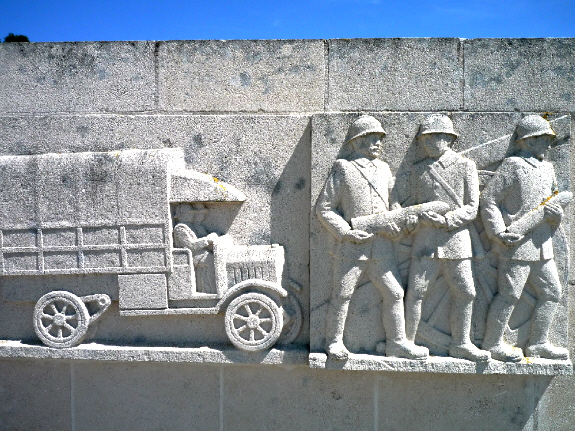
Detail from the Memorial
Between March and June 1916, when a new standard gauge railway line began to take the pressure off the road, the monthly traffic on the Voie Sacrée exceeded half a million tons of supplies and 400,000 troops, in addition to the 200,000 wounded men evacuated by ambulances, many driven by young Americans. By December 1916 almost two and a half million men had been carried along it. Throughout the First World War, no other single route carried as much traffic for as long a period as did the Voie Sacrée and today every kilometre of the route is marked by a memorial marker stone.
So if you are ever in Verdun, go and visit the memorial to this famous supply road, which you will find at Maison Brulée, a tiny hamlet some 8 kilometres south of the city. Go also to Fleury Memorial Museum on the battlefield and inspect one of the little trucks that made that journey and think about the men who drove them, grinding forward with dimmed headlights, day in and day out, whatever the weather, to supply the longest battle of the First World War.
|
|
|

Early Trench Warfare
German Soldiers Improvising Hand Grenades
|
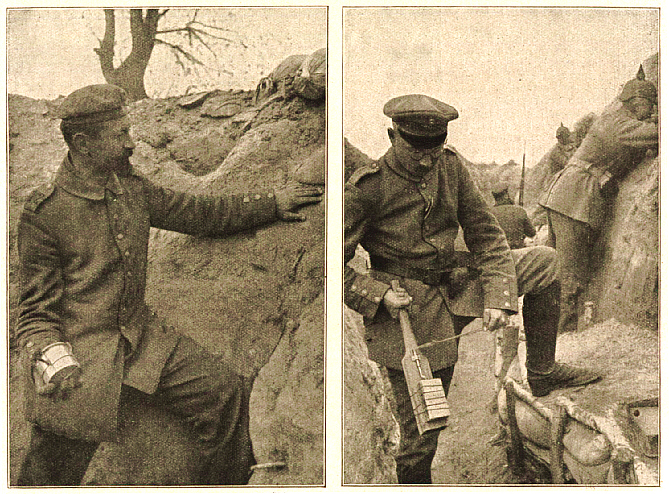
|
Click Here to Visit the Website of Our Contributing Editor Tony Langley
War in a Different Light

|
|
Subscribe to Our Online Magazine
|
|

|
|
|
Page Three
|
|
|
A Kentuckian at Gallipoli
By Paul Guthrie and Paul Bennett
|

Memorial Hall |
Memorial Hall at the University of Kentucky in Lexington is a memorial to the approximately 1,000 Kentuckians who died in uniform in World War I (about half were combat related). It is a lovely building in the style of a New England church with a tall steeple and an outdoor amphitheater in the rear. Inside, on the walls, Kentucky's 120 counties are listed alphabetically, with the dead of that county listed alphabetically.
A bronze plaque on an inside wall bears the names of the 20 University of Kentucky men who died in World War I, eight of them in combat. The first name on the plaque is Frank Matthew Coffee, who died 18 November 1915, well before the United States entered the war, while serving as a Lieutenant with the 24th Battalion Australian Imperial Forces, Gallipoli. How did this young Kentuckian die in a foreign army and foreign land?
The son of an American who went to Australia to find his fortune, Coffee decided to study in America. In 1902, he left Australia for Lexington, Kentucky, where he attended the University of Kentucky, then Kentucky State University, an institution of 379 students, with 61 faculty (now over 25,000 students and called the University of Kentucky). He studied engineering at the University for two years, after which he returned to Australia, and by 1915 was working as a journalist.
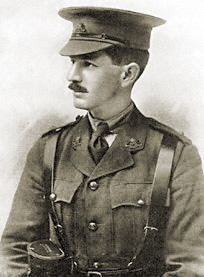
Lt. Coffee |
Frank attested to the Australian Imperial Forces 13 January 1915 as a private soldier, and was commissioned second lieutenant 24 March 1915. He traveled with the AIF to Egypt and, ultimately, Gallipoli, and was attached to his battalion 16 September 1915. Frank was hit 15 November 1918 by a 75mm artillery shell. He was eventually buried at Lone Pine Cemetery. [Ed. We will be presenting Frank's full story on our Website. Here we present a brief excerpt for Trip-Wire readers. It's a fatalistic letter to his father.
One never knows when one may be wounded or killed out here, so I take every opportunity of writing. Escapes, narrow escapes are so frequent that unless actually hit, one barely notices danger. And everything comes so unexpectedly. For instance down in the gully where we rest in the habit of considering ourselves quite safe from shellfire; but yesterday morning just as I left the quartermaster's store to return to my dugout, a shrapnel shell burst just above me. I was spattered with about five or ten bullets and a jagged piece of the shell case struck between my feet. The shell burst a shade too high, and consequently the bullets had lost of their force so I was quite unharmed. And so it goes. When my turn comes I shall get it; but Abdul - as we call the Turk - will have to use better aim and time his shells better. Hope I never get it!The full article from which this excerpt was selected originally appeared in
the Western Front Association's journal
Stand To!, September 2002.
|

Left: Acute Case Affecting Gums & Hard Palate; Right: Less Severe But Painful Case
Contributed by Donna G. Wagner, R.D.H.
Trench mouth, a noncontagious disease also known as Vincent's angina and Vincent's stomatitis, flourished in the trenches during during World War I. It was brought on by exhaustion, emotional stress, and poor health conditions, such as deficient diets, tobacco use, insufficient rest, and poor oral hygiene. All these conditions conspired to cause two microorganisms of the mouth to invade its susceptible tissues. If untreated, this caused extreme pain as the bacteria attacked the gum tissue, causing a gray membrane composed of the bacteria and dead or necrotic tissue to appear which would slough off when touched, leaving raw bloody tissue underneath.
Often the first sign was that the soldier's breath would become extremely foul. Ulcerations on the papilla, or points between the teeth would cause them to become blunted and gaps would show between the teeth at the roots. Swallowing became painful as lymph nodes in the throat would swell. Eventually, supporting bone would deteriorate.
Treatment during World War I would have consisted of warm saltwater rinses, hydrogen peroxide application or rinses, and, if possible, better food and removal of the patient from the stressful trench area. Today the disease is treated in the same manner, but with the addition of antibiotics such as tetracycline or amoxicillin. The disease is mainly seen today in people with extremely depressed immune systems. Mild forms are found in college students at exam time, people with high stress levels, or heavy tobacco users. Formally, it is called Acute Necrotizing Ulcerative Gingivitis, or ANUG.
|
|
|
 |
Six Great Fictional Reads on
Americans at War
Recommended by Editor Mike Hanlon
|
I'm currently helping compile The Great War Society's recommended bibliography of the best books on the Great War. More will be written about that project in future issues of the Trip-Wire. Many people have contributed suggested titles, but some of my favorites aren't making the list. (Insert Smiley Face icon here with frown.) So I've decided to exercise my editorial prerogatives here in the Trip-Wire. Please enjoy some of these works if you have time and send in your comments. I'll pass them on to some of the panelists who are advising us. (email). This six-pack focuses on novels that shed some insight about the U.S. involvement in the war and the experiences of American soldiers, sailors, and marines.

The US Naval narrative, Delilah, (Lyons Press, 2000, paperback) concludes just as America enters the war. Nonetheless, it is to life on a coal-fired ship of the line from that period what Moby Dick is to 19th century whaling. . .In Over There, distinguished historian-novelist Thomas Fleming explores the character and milieu of the most important member of the American Expeditionary Force, its commander, General John J. Pershing. This is not a battle account. Its value is in its excellent insights into Pershing's earlier service, his grasp of his duties and responsibilities in France and his ruthless hardness in exercising them; the charm he could unleash on superiors: the magnetism he held for ladies: and the scorching pain he felt over the deaths of his wife and daughters in the 1915 San Francisco Presidio fire. . .My favorite description of the air war over the trenches is contained in Derek Robinson's story of a British SE-5a unit, Goshawk Squadron (a must read). I've despaired of ever finding an equivalently perceptive work on the American Air Service. In his last book, however, the late best-selling author Jack D. Hunter (The Blue Max) does a credible job. The Ace (Blue River Press, 2008) has fascinating background on the aviation industry and the politics behind the new air service, but it all leads up to the conclusive action over the Western Front. . .Now, here's a question for you. What is the closest American equivalent to All Quiet on the Western Front? Some might recommend Thomas Boyd's Through the Wheat, others, William March Campbell's Company K, recently made into an interesting film. I'm splitting my vote, however, between Chevrons (Doran, 1926) and Squad (Coward-McCann, 1928) by Leonard H. Nason (something of pulp writer) and James Wharton, respectively. These two novels seem to me to present the grittiest, most fully textured renditions of the Doughboys' battle experience. (Both titles are a little tough to find, unfortunately). . .Last, recently reissued, is the American equivalent (IMHO) of Siegfried Sassoon's fictionalized memoirs, Plumes (Univ. of South Carolina Press, 2007) written by well-known Marine amputee, Laurence Stallings. As the troops might say without irony, he talked the talk and walked the walk." Plumes focuses on a wounded, somewhat embittered veteran putting his life together. Yes, it's really the author's own story.
|
|
|
|


















